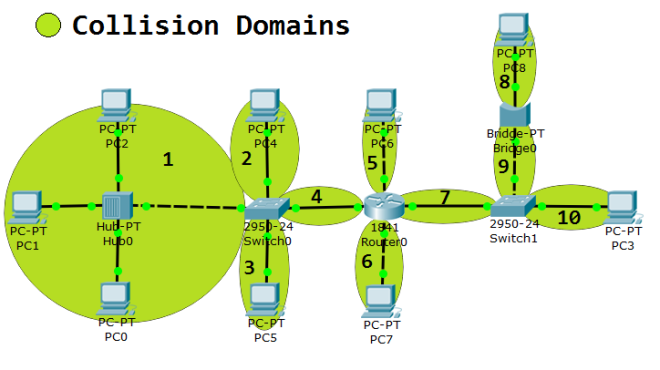Terms you need to understand.
Broadcast: In this case, a Data-Link layer (Layer 2) message sent to ALL devices attached to the same network segment.
Collision: When more then one device transmit data at the same time on shared media, the packets collide, data becomes corrupted and after a random period of time, devices have to re-transmit the data.
Broadcast Domain: All devices that a Broadcast message reaches at the Data -Link layer within a network is called a Broadcast domain. A network can have more then one Broadcast domain and a Broadcast domain is delimited by devices that stop Broadcast messages.
Collision Domain: Anywhere within a network where a Collision can occur. The limits of a Collision domain are marked by those devices that break up Collision Domains.
Network Devices and their role regarding Broadcast and Collision domains:
Switch: Expands Broadcast domains and breaks up Collision domains.
Every device attached to a Switch belongs to the same Broadcast domain and this is because every port on a Switch belongs to the same Broadcast domain. If you were to attach another Switch to the original Switch, every single device attached to that second Switch will also belong to the same original Broadcast domain. In other words, every time you add a switch to a network, you expand the Broadcast domain.
It is said that a Switch breaks up Collision domains because each port on it is its own collision domain, as apposed to a Hub, for example, where all of its ports belong to the same Collision domain.
Bridge: Expands Broadcast domains and breaks up Collision Domains.
The Bridge is just like a Switch; it expands Broadcast domains and breaks up Collision Domain. Each port on a Bridge is its own Collision domain.
Hub: Expands both Broadcast and Collision domains.
A Hub will expand a Broadcast domain just like a Switch does, but, as opposed to a Switch, it does not break up a Collision domain because every single port on a Hub belongs to the same Collision domain. In other words, a frame that came in or out on one port can collide with any other frame from any other of the Hub’s ports.
Imaging yourself adding Hubs to a network, every time you add a Hub, both the Broadcast and the Collision domains get expanded.
Router: Breaks up both Broadcast and Collision domains.
Each interface on a Router is its own Broadcast and Collision domain. This means that Routers stop Broadcast messages, they will not route a Broadcast message from one Broadcast domain to another Broadcast domain.
Broadcast Domains.

Look at the picture above, you can identify 4 different Broadcast Domains, let’s see why:
Broadcast domain #1:
- Each interface on a Router belongs to its own Broadcast domain: TRUE.
- Each port on a Switch belongs to the same Broadcast domain: TRUE.
- Each port on a Hub belongs to the same Broadcast domain: TRUE.
Broadcast domains #2 & #3:
- Each interface on a Router belongs to its own Broadcast domain: TRUE.
Broadcast domain #4:
- Each interface on a Router belongs to its own Broadcast domain: TRUE.
- Each port on a Bridge belongs to the same Broadcast domain: TRUE.
Collision Domains.

Looking at the picture above, you can identify 10 different Collision domains, let’s see why:
Collision domain #1:
- All the ports on a Hub belong to the same Collision domain: TRUE.
- Each port on a Switch is its own Collision domain: TRUE.
Collision domains #2, #3 & #4:
- Each port on a Switch is its own Collision domain: TRUE.
- Each interface on a Router belongs to one Broadcast domain: TRUE.
Collision domain #5, #6 & #7:
- Each interface on a Router belongs to one Broadcast domain: TRUE.
- Each port on a Switch is its own Collision domain: TRUE.
Collision domain #8 & #9:
- Each port on a Bridge is its own Collision domain: TRUE.
- Each port on a Switch is its own Collision domain: TRUE.
Collision domain #10:
- Each port on a Switch is its own Collision domain: TRUE.
Last Tip.
If you learn the role each network device plays regarding Broadcast and Collision domains, you will be able to recognize them on a network very easily.
Exercise video:



One thought on “Broadcast and Collision Domains.”